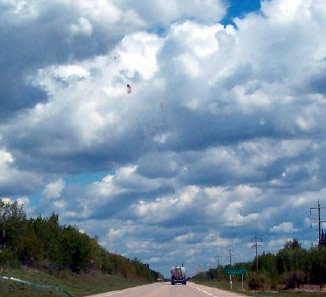
I had never been to Fort McMurray before. It seemed
the obvious choice, though, when I decided to do fieldwork
for my MA thesis on people’s perceptions
of the health risks posed by the oil and gas industry.
So, with no personal contacts, I booked a room
in a camp and headed up on June 1, 2004.
Desperate prayer convinced
my 1980 VW Rabbit that it could handle the 439 km from
Edmonton to Alberta’s
oil and gas frontier. I set out alone in the morning
and took my time on the highway, which I had been
warned could get pretty crazy. Fortunately there
was little traffic, and those who wanted to pass
me could do so without waiting (how fast was I going?
I have no idea. My speedometer doesn’t work…).
I stopped for lunch in Wandering River, swayed by
the ominous “NO GAS OR SERVICE FOR 102 KM” sign.
I parked my shiny white Rabbit between muddy pickup
trucks, and sat in the corner of the Crossroads Café in
an attempt to avoid subjecting myself to the examination
of the elderly Ukrainians having the special.

Wlife did not make many appearances on my trip.
Deer tally: 2
Live gophers: 1
Dead gophers: 2
Crows eating dead gopher: 3
I found my camp with no problem, and am amazed at
my strength in not crying at the sight of my room.
The aroma immediately pronounced me a non-smoker, and
I hoped never to sweat so much as to be nauseating
to room entrants days after my departure. Not having
the foresight to ask, I had come without linens,
and could find none in the closet of my smelly 10x10
room. With ingrained blue-collar stoicism, I crammed
my luggage and supplies for two months into my new
home, opened the window, and dragged my camping blanket
out of the trunk. Wal-Mart has made it up here, and
the camp manager suggested sheets would be cheap,
as well as a bowl and cup for dinners—I hadn’t
brought any dishes, either, and the communal kitchen
doesn’t supply them.
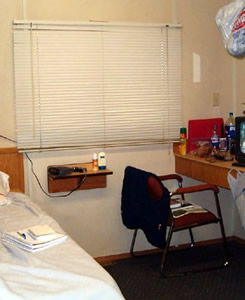
The women’s washroom is tolerable. The men share
a charming little room with rows of toilet stalls
next to shower stalls. Somehow, that doesn’t
seem like a satisfying cleansing. Our washroom, however,
looks like a regular house’s: fuzzy thing on
the toilet seat, flowered shower curtain (with a
touch more mold than any house I’ve ever lived
in—and I once lived with four boys), and best
of all, a lock! While the men have no idea who’s
lurking outside their stall, I can be assured that
nobody is going to be in the room when I open the
curtain. Being a single girl in city full of men,
I’ve been told by most Edmontonians to watch
my back.
The people in the camp, for the most part, seem friendly. “Jimmy” was
waiting in the office when I went to check in, and
stared at me in a way that made me wish I could gain
eighty pounds by blinking. He suggested that I get
a room in his trailer. I suggested that I not. Fortunately,
fate agreed with me, and there is an entire trailer
between us. I found someone with a soccer ball, so
on the first night we employed the muddy parking
lot as a field and played pass for a bit. Jimmy insinuated
himself, and I remembered I needed to use the phone.
My best ally so far has been “Rob,” who
was sent to show me how to use the internet connection
here (dial-up. Boo.). Rob asked what I was doing
up here, and seemed interested in the project. Rob
is an ex-social worker who moved up here to make
some money and get away from human services for a
while. He is Metis, and very interested in the history
of Western Canada. After just a bit of digging on
the internet, he found out for me that I am also
Metis; a few generations ago, Caroline Whitford took
scrip. With this information, Rob says, I can receive
Metis status myself. I think I will have to think
about this for a while, and examine what exactly
my motivations would be for doing so. Until then,
I will “walk proud,” as Rob suggested.
My only planned entry point to the community was the
Nistawoyou Native Friendship Centre in Fort McMurray.
When I walked in on my first full day in town, Rob
was there, and he introduced me to some of the people
involved in the Centre. Everyone there has been eager
to tell their stories, and I think I’ve been
very lucky to come across them. I have offered to
help out at the Centre, and will be volunteering
at their National Aboriginal Day celebrations on
June 21. Having been told I look like I’d be
good with technology, I’ve been put in charge
of running the videos that will be shown.
Rob was kind enough to take me on a bit of a tour of
the region. From the Friendship Centre, we went to
a local union office, and they offered to help round
up some of their members for interviews. I will be
making a visit to them on June 14, when they have
a board meeting, and the President has offered me
some office space and will shuffle in someone to
talk to me every half hour or so. After the union
office, we headed out to see Syncrude’s lands.
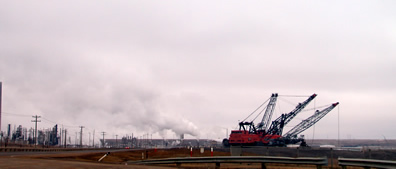
The landscape here is beautiful. Dense boreal forest
covers all the hills, and the rivers carve paths
that scream to be photographed; this, of course,
only until cresting the hill before Syncrude’s
lease. Suncor’s lands are better hidden from
the highway. The landscape of oil sand extraction
is completely alien. Trucks, open pits, extraction
equipment, processing facilities, sulphur blocks
and expansion construction have transformed the boreal
into something better suited to dystopic movies about
the future. The soundscape, as well, is bizarre:
constant droning of equipment is punctuated not by
birdcalls, but by periodic banging or explosions
(at this point I don’t know enough about the
process to know what that sound is).
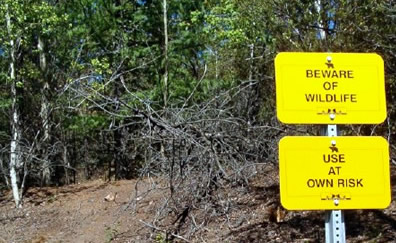
I took a solitary trip to the “Wood Bison Trail,” where
the guide map promised I would be welcomed “back
to nature.” The trails are on Syncrude’s
reclaimed land, and are offered as a testament to
Syncrude’s commitment to “developing
productive landscapes.” Signs are displayed
throughout the trail system that inform the nature
enthusiast of what species were planted on that section
of land. Visitors are warned to beware of wildlife—by “wildlife,” I
must assume that they mean mosquitoes, grasshoppers
and bees. Aside from insects, I saw about three birds,
a beaver lodge and some dog shit. With the surrounding
operations, and the small size of the reclaimed land,
I can’t imagine that anything much larger than
four inches would choose to make its home at Syncrude.
The company has planted 30 wood bison on its reclaimed
land, and hopes to produce numbers significant enough
to help repopulate the herds in Wood Buffalo National
Park. Despite having had 11 years, they do not appear
to be close to their goal; despite claims of the
animals being healthy, they have spent their winter
penned and being fed hay, rather than foraging. Syncrude
employs the image of the wood bison at the beginning
of their lease, with some huge bison carvings on
slabs of siltstone welcoming employees and visitors.
While it would be satisfying to believe that Syncrude
is genuinely interested in the welfare of the species,
the cynic in me suggests that it is simply a convenient
marketing tool. Not only does Syncrude use the bison
where convenient, but the company also does not hesitate
to point out that they used actual Aboriginals to
create both the carvings and the trails.
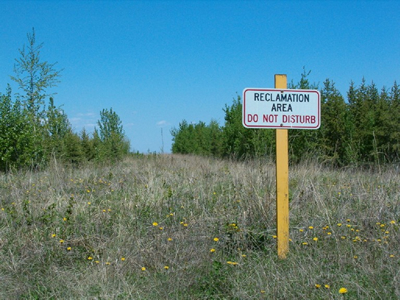
The upper portion of the trail is named the Matcheetawin
Discovery Trail. Matcheetawin (which the guide helpfully
informs the reader is pronounced “match-eet-a-win”),
says Syncrude, is Cree for “beginning place;” my
friend Rob tells me that it is a Cree word, but it
doesn’t mean beginning place. I wish I could
remember what it does mean; next time I see Rob,
I’ll ask again.
All cynicism aside, I am pleased with my first week of
fieldwork ever. I haven’t cried, I don’t
think I’ve offended anyone seriously, I still
have some money, I’m learning things, and my
only physical harm has been a cold that kept me cranky
in bed for all of Sunday. Next week holds promise.
I will spend more time at the Friendship Centre,
and hopefully get some actual interviews done. So
far, the conversations I’ve had indicate that
there is much concern about health and environment
here, and that my research is timely (although I
don’t have the ego to say important, I’d
kind of like to think it might be…).
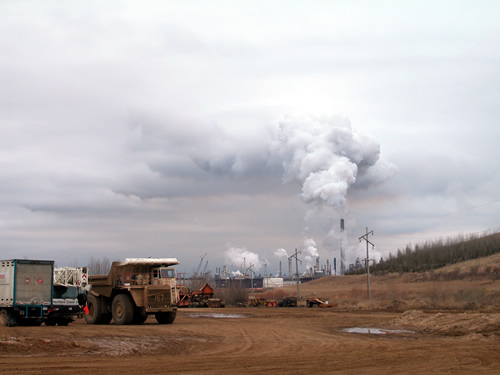
|



